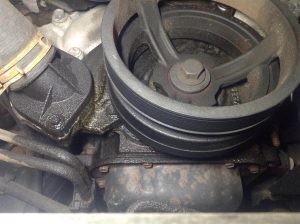Common Causes of An Engine Oil Leak
 An oil leak can be super frustrating for most car owners. While the exact cause can be difficult to diagnose on a vehicle, most leaks can be prevented through simple, regular maintenance. Here are some of the common causes and what you can do to avoid them.
The Oil Filter
Oil filters wear out over time making them a common culprit of leaks. Some vehicles also have additional parts in the filtration system, at the filter, which can also leak. Your mechanic should change the filter every time you have your oil changed and check that it fits properly, as a loose or misaligned filter can also cause leaks.
The Drain Plug or Filler Cap
At the base of the oil pan is a drain plug. A plug with worn-out threads, misaligned threads, or one that’s simply loose can be another cause of an oil leak. The pressure of the engine can also cause oil to spill out while the vehicle is running, if your filler cap is missing, loose, or broken. Ensure both are in good condition and properly sealed to help prevent leaks.
The Valve Gasket
This is probably the most common cause of oil leaks, especially in vehicles with high mileage. The valve gasket joins the engine block and oil pan. Over time, the pressure in the seal increases which can cause leaks and failures, especially if sludge (the oil that breaks down over time) is built up. Getting regular oil changes reduces the build-up of sludge which, in turn, helps to increase the longevity of your gaskets.
How to Check for Leaks
To check for engine oil leaks, keep a close eye on your oil dipstick. Be sure sure to check when the engine is cool, preferably after the engine has been sitting overnight. If you see the level dropping over time, that’s a good indication that you’re losing oil. You can also see if blue smoke is coming from the tailpipe while driving or if you smell burning oil. This indicates that oil might be leaking into the engine or onto hot components of the engine, respectively.
You can also look for the classic oil stains under the engine compartment, especially if it’s been sitting overnight. An easy way to spot stains is to put newspaper or tin foil under your car overnight and see if there are any stains on it in the morning. Brown liquid usually indicates an engine oil leak, red is usually transmission fluid, and green or orange is typically coolant. For more information on diagnosing leaks, check out last week’s article.
At V&F
Problems with your oil system can require expensive repairs, but getting them serviced right away will save you money in the long run. Leaks can prematurely degrade rubber hoses or seals but, worst of all, oil leaks are a fire risk in your own engine compartment which can result in engine failure.
The best way to fix an oil leak is to take it to your mechanic for professional repair. Service may be more expensive than a YouTube DIY, but the fix will be long-lasting and you know we’ll get the job done right. At V&F, our expert mechanics use the latest diagnostic equipment, and high-quality CARQUEST auto parts, to make sure we get the job done right. Plus, our auto repair services are backed by an industry-leading 3 year / 36,000-mile warranty on parts and labor. Call us today at (413) 314-2280 or schedule an appointment online.
An oil leak can be super frustrating for most car owners. While the exact cause can be difficult to diagnose on a vehicle, most leaks can be prevented through simple, regular maintenance. Here are some of the common causes and what you can do to avoid them.
The Oil Filter
Oil filters wear out over time making them a common culprit of leaks. Some vehicles also have additional parts in the filtration system, at the filter, which can also leak. Your mechanic should change the filter every time you have your oil changed and check that it fits properly, as a loose or misaligned filter can also cause leaks.
The Drain Plug or Filler Cap
At the base of the oil pan is a drain plug. A plug with worn-out threads, misaligned threads, or one that’s simply loose can be another cause of an oil leak. The pressure of the engine can also cause oil to spill out while the vehicle is running, if your filler cap is missing, loose, or broken. Ensure both are in good condition and properly sealed to help prevent leaks.
The Valve Gasket
This is probably the most common cause of oil leaks, especially in vehicles with high mileage. The valve gasket joins the engine block and oil pan. Over time, the pressure in the seal increases which can cause leaks and failures, especially if sludge (the oil that breaks down over time) is built up. Getting regular oil changes reduces the build-up of sludge which, in turn, helps to increase the longevity of your gaskets.
How to Check for Leaks
To check for engine oil leaks, keep a close eye on your oil dipstick. Be sure sure to check when the engine is cool, preferably after the engine has been sitting overnight. If you see the level dropping over time, that’s a good indication that you’re losing oil. You can also see if blue smoke is coming from the tailpipe while driving or if you smell burning oil. This indicates that oil might be leaking into the engine or onto hot components of the engine, respectively.
You can also look for the classic oil stains under the engine compartment, especially if it’s been sitting overnight. An easy way to spot stains is to put newspaper or tin foil under your car overnight and see if there are any stains on it in the morning. Brown liquid usually indicates an engine oil leak, red is usually transmission fluid, and green or orange is typically coolant. For more information on diagnosing leaks, check out last week’s article.
At V&F
Problems with your oil system can require expensive repairs, but getting them serviced right away will save you money in the long run. Leaks can prematurely degrade rubber hoses or seals but, worst of all, oil leaks are a fire risk in your own engine compartment which can result in engine failure.
The best way to fix an oil leak is to take it to your mechanic for professional repair. Service may be more expensive than a YouTube DIY, but the fix will be long-lasting and you know we’ll get the job done right. At V&F, our expert mechanics use the latest diagnostic equipment, and high-quality CARQUEST auto parts, to make sure we get the job done right. Plus, our auto repair services are backed by an industry-leading 3 year / 36,000-mile warranty on parts and labor. Call us today at (413) 314-2280 or schedule an appointment online.
 This article was originally published in January 20218 and has been updated.
This article was originally published in January 20218 and has been updated. 